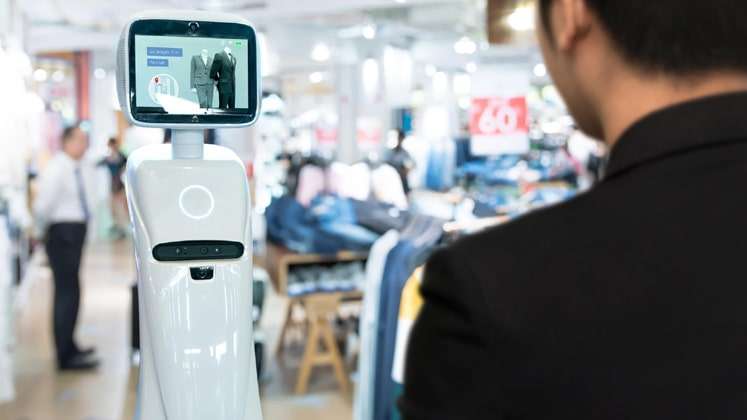
Industry 4.0 combines electronics and information technology enabling complete digital connectivity by bringing the physical, digital and organic elements of modern human life. It is the interaction between the advanced technologies like Artificial Intelligence (AI), Machine Learning (ML), automation, Internet of Things (IoT), 3D printing, Augment Reality (AR), Virtual Reality (VR), robotics, etc. transforming the way businesses perform.
Fashion industry, like any other industry, is also utilising the benefits of advanced technology to stay ahead in the competition. Industry 4.0 is helping optimise the layout of smart connected stores, improving inventory levels, establishing better interactions and enhancing the fashion supply chain.
Moreover, it provides actionable insights to guide the business decisions by quickly connecting and visualising data across various systems. Applying the technology also allows retailers to sense trends and respond to the market need quickly, giving retailers an upper hand over its competitors.
Cloud computing, big data and robotics have played a transformational role in retail automating the processes for better results. This has created better understanding of the businesses and, therefore, re-strategising business that fits into today’s world.
Cloud computing for design creation
Cloud computing is basically the on-demand availability of computer system resources, especially data storage and computing power. Big data and cloud computing differ; while the former is used to describe huge volume of data and information, the latter is a technology used to store data and information on a remote server rather than on a physical hard drive.
Fashion retailers are using the technology to better manage their inventory by conducting a real-time inventory tracking including stock availability, store orders, and shipping details. In addition to this, retailers can also have complete access to the information they need and will also be able to better anticipate customer demands. As today retailers are looking out for ways to enhance the online shopping experience for the customers, they are shrinking their delivery time to days and even hours. A transparent view of the inventory across its different stores, warehouses can help the retailers fulfill a demand from the nearest warehouses and stores for quick deliveries.
One of the fashion tech companies utilising the power of cloud computing is Stitch Fix . The company technology uses recommendation algorithms and data science to deliver hand-picked personalised clothing recommendations to the customers online. Customers are required to fill out a survey form to determine their style, size and price preferences. The technology considers each style as Hybrid Design. They think of each style as collection of attribute such as color, length, neck style etc. Then based on the feedback, it recombines the attributes to create a new design. These designs are shared with human designers for approval on final outlook.
Another use of the technology is a project for which IBM Watson and designer duo Falguni and Shane Peacock collaborated where the designers created dresses based on the results suggested by the IBM tool. Watson Visual Recognition API analysed around 600,000 publicly available images including the leading fashion weeks of London, Paris, Milan and New York to gain insights into high-end couture.
Additionally, fashion trends from Bollywood were also analysed using around 5,000 pictures on different social media sites. The API analysed to find the most trending and liked trends from this wide number of images. A pattern generation tool used AI for creating unique patterns that were used in the designs. The results also helped them analyse the trendiest colour of the season using which they created three unique dresses that were completely based on Watson technology results.
The machine generated designs help designers to increase their time to market and stay ahead in the competition by creating most up-to-date collections. This will eliminate the extra amount of time required in the traditional designing process enabling access to huge amount of data for understanding the trend better.

Big data for customer support
Big data is simply huge amount of data both in organised and unorganised form. The data collection and analysis is helping companies understand the performance and anticipate the future much better. Fashion industry has huge amount of data but how much of it is being used for making the right decisions is a tough question.
Customer service is an important factor for the retailers. Today retailers are collecting customer data and analysing it to provide them more personalised service. Retailers need to understand their customers based on demographic factors like age, gender, ethnicity etc. and personal information, sales data, purchase pattern and liking. Big data allows companies to capture every data including reviews and complains of the customers.
Today customers are using social media platforms for sharing information even about a brand and product. Big data can easily analyse the data present on these websites to respond to a customer issue immediately, and therefore, reducing a negative customer experience. It also helps analyse which channels are being used majorly by the retailers to focus more advertising and marketing efforts on that website.
The collection and analysis of a customer purchase history is assisting retailers to give personalised recommendations and offers to the customers. The customer profile has a record of each of the customer activity on the website the product they searched for, the type of products they buy, the brand they prefer, product in cart etc. Big data studies these data and analyse it to offer them recommendations that would meet their liking. This helps in increasing positive customer experience on the website, and therefore, leading to customer loyalty.
Other application is offering omnichannel support, which is offering customers the path to purchase through different touch points and channels. Tracing customer journey helps retailers to understand the most important platforms and parts that need attention. Big data processing and analysis help identify which channels they are missing and are not integrated and where customers are abandoning their journey. It also helps understand the important areas, where customer service is the weakest, different price point expectations across channels. The insights help create a fully integrated omnichannel environment leading to better sale.
Big data also offers another application – Conserving Brand Integrity by Image Recognition technology, a subset of artificial intelligence which is combined with big data for encountering the challenge. Image recognition is basically the ability of the software to identify images, objects, people and places. Computer uses machine vision technology with AI and camera for performing image recognition. This makes a system capable of identifying an image similar to that of humans.

Robotics as sales representatives
Today AI robots are being used as sales representatives for interacting with the customers shopping in the stores. These are handling not just the physical task, but are also managing more cognitive tasks by a learning algorithm that integrates decision making capabilities in them. Robots are being used both in humanoid and non-humanoid forms. Their main advantage is labour saving, efficiency and uptime. They can help customers in locating product in the store and guide them around the store.
An example for the same is LoweBot, a 5-feet tall non-humanoid robot shopping assistance that helps customers search for a product in-store. It acts similar to a human sales representative and can perform tasks like helping them find a product, smart recommendations and offers through the touch display. Not just this, LoweBot also travels on the shop floor scanning the shelves and delivering inventory updates to the store associates. This also helps understand the shopping pattern at the location, so that the retailer can not only re-stock the product, but can also understand its performance.
MITRA is another example – it is a humanoid robot developed for enhanced customer engagement in-store. Encapsulated with three main technologies like face recognition, conversational abilities and autonomous navigation, these robots are capable of recognising a customer by face, identifying age, gender and other information. The customers are greeted on their repeat visits which make them more interactive and fun. It can also make conversations and give them reviews and suggestions.
Recently the company unveiled MITRA 3, the brother of MITRA Robot. MITRA 3 humanoids are built for a more interpersonal engaging experience of the customers. These robots, unlike MITRA, are integrated with the eyes and can also imitate eye movements and human gestures. These robots are more flexible, as they have three degrees of freedom (shoulder, elbow and finger movements), thus allowing them to welcome guests with ‘Namaste’.

Leave a Reply